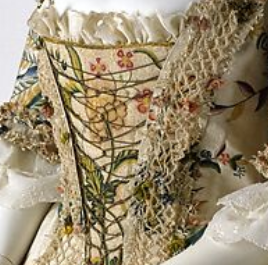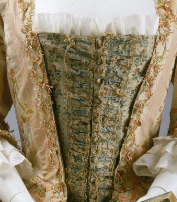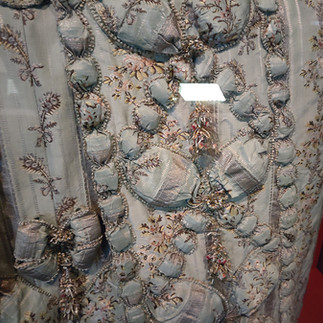Weaving Silk Stories - research - Fly Fringe & Band Weaving
- Stephanie Smart
- Jul 18
- 10 min read
Updated: Jul 25
Early on in the research for the collection Weaving Silk Stories I could see that certain decorative techniques were repeatedly showing up on garments from the historical periods I was considering and I knew I had some learning to do. That is, I knew I would need to research both the history of the use of certain techniques and how to practise them.
A widely used and therefore obviously popular and particular type of decoration that I started spotting on many mid 18th century gowns was a type of fringe created using knotted silk thread. This technique is known today as fly fringe.
My first experimental length of fly fringe
Though it reached the height of its popularity as an applied trim on garments in the 1760s-'70s it seems that many of the same techniques were being used in passementerie for interior decoration in the 1600's. Here you can see it included in the design of a tassel made for a grand French interior by Declercq Passementiers in Paris from the display cabinets in which they house some stunning historical examples dating back to the time of Louis XIV.
And whilst that term - passementerie - was a new one to me when I began researching historic fashion knowing more about it was to become key to the making of Weaving Silk Stories (so it will feature often in the posts about this project).
"Passementerie (/pæsˈmɛntri/, French pronunciation: [pɑsmɑ̃tʁi]) or passementarie is the art of making elaborate trimmings or edgings (in French, passements) of applied braid, gold or silver cord, embroidery, colored silk, or beads for clothing or furnishings.
Styles of passementerie include the tassel, fringes (applied, as opposed to integral), ornamental cords, galloons, pompons, rosettes, and gimps, as well as other forms. Tassels, pompons, and rosettes are point ornaments, and the others are linear ornaments."
There are records of fly fringe being used on gowns as early as the 1730s and it was to be found on many garments and accessories throughout the 1700s.

Please click on the image l in this post to be linked direct to its source
Woman's Bag (Reticule), France, circa 1799, Silk satin with weft-float and supplementary weft patterning, silk floss and chenille passementerie with silk fly fringe, and silk cord, 9 x 9 in. ( 22.86 x 22.86 cm) Gift of Mr. and Mrs. Robert D. Mathey (M.83.281.2)
By clicking this link you can see more examples of fringing on a cap 1740-1760 © Victoria and Albert Museum, London https://collections.vam.ac.uk/item/O360878/cap-headgear-unknown/
Here are three more examples on another a reticule and cap, as well as a cape. Have a look at the edging of each:
I highly recommend watching this video by Romantic Recollections as a brilliant overview of both the history about the making of fly fringe: https://www.youtube.com/watch?v=WSLR3THJL2I
If you would like a more in depth take Denise Hendrick has written a thesis - Flights of Fancy: The rich diversity of eighteenth- century passementerie
Some of the images I show in this post are from her video where everything is fully attributed.
I also found this site a good resource: http://www.larsdatter.com/18c/fly-fringe.html
Here is nice image showing how each fly can be attached to one another to form a fluffy little group which can be hung as in the images above

Fly fringe was often combined with other types of knotted, twisted, netted braid using, here is a close up of a dress in the costume collection at Worthing Museum, Sussex, showing how thread has been manipulated into trim in a myriad of ways
All of these techniques can be seen also to have been combined with other types of embellishment (folds, pleats, quilting etc) to create richly textured decoration, often with the addition of thread or fabric covered buttons.
First then some examples of where fly fringing has been combined with other types embellishment on the front of dresses. Please double click on each image to link directly to the source.
Woman's Gown (robe à l'anglaise) 1750-1785. Chinese fabric, made in England. Plain weave silk, polychrome paint, and silver. 72 x 28-3/4 in. Historic Deerfield, Deerfield, Massachusetts, Gift of Henry N. Flynt and Helen Geier Flynt, HD F.287
Woman's Gown (robe à la française), 1735-1775. Dutch or French, Silk satin ground brocaded with supplementary silk wefts, plain weave linen lining, Historic Deerfield, Deerfield, Massachusetts, HD F.660
Robe à la française, The Met Museum 1740s, British, silk, pigment, linen, Harris Brisbane Dick Fund,1995.235a, b
Robe à la française, The Met Museum1760–80, British, silk, Rogers Fund, 1925 Object Number: 25.12a–c
Robe à la française, The Met Museum 1750–75, French, silk, Purchase, Irene Lewisohn Bequest, 1959, C.I.59.29.1a, b
The last image in the group above shows a woman's dress and petticoat (Robe à la française). Probably The Netherlands, circa 1775 Silk plain weave (faille) with supplementary weft-float patterning, moiré finish, and silk passementerie with silk fly fringe. Center back robe length: 62 in. (157.48 cm); b) Center back petticoat length: 34 1/4 in. (86.995 cm). Purchased with funds provided by Suzanne A. Saperstein and Michael and Ellen Michelson, with additional funding from the Costume Council, the Edgerton Foundation, Gail and Gerald Oppenheimer, Maureen H. Shapiro, Grace Tsao, and Lenore and Richard Wayne (M.2007.211.926a-b)
These are some of the others I looked at:
https://historicaldress.tumblr.com/post/180758969737/sacque-gown-john-hancock-estate-c-1755-1760/amp
Here you can see fly fringe combined with other types of trim on sleeves:
Please double click on each image to link direct to the source or expand
Here is a close up on a sleeve with fly fringe on it. The dress is a brocade sack back open robe 1765-1775 which was lot 304 on march 30th 2011 at Augusta Auctions
Please double click on the image to link direct to the source
And here are a couple more examples:
It was sprinkled across dresses, including on bodices and stomachers:
Please double click on each image to link direct to the source
Robe à la française The Met Museum 1750–75, French, silk, purchase, Irene Lewisohn Bequest, 1959, C.I.59.29.1a, b
Robe à la français The Met Museum1740s British, silk, pigment, linen Harris Brisbane Dick Fund, 1995.235a, b
Robe à la française The Met Museum 1775–1800 French, silk, purchase, Irene Lewisohn Bequest, 1961 C.I.61.13.1a, b
The Museum of London see below
Here are a couple of amazing example from the collection of MFA Boston:
And some others:
Please double click on each image to link direct to the source
Sometimes the knots weren't only in the middle of the fly as in the picture of my own first attempt above but were also at the ends. The fluffy, tassel end might then be bent over to create a loop or bunched up. This meant that small clusters could be incorporated into fringe, scattered across an item or left hanging like tassels, quite often hanging over areas of looser weave net effect trim:
Please double click on each image to link direct to the source and on the arrows on the image to expand it
You can see netting examples in these two aprons:
and on a shawl over a dress of yellow atlas with silk embroidery from the middle of the 18th century © The Nordic Museum registration number 171126 https://digitaltmuseum.org/011013849830/drakt-av-gul-atlas-med-silkebroderier-1700-talets-mitt-nordiska-museet
I like these three examples of skirt decoration because fringing is combined with the drama of puffed fabric creating very raised textures.
Please double click on each image to link direct to the source
Dress ca. 1775 The Met Museum French, silk, Isabel Shults Fund, 2005 61a, b
Robe à la française, The Met Museum, 1775–1800, French, silk, purchase, Irene Lewisohn Bequest, 1961 C.I.61.13.1a, b
Sack-back gown with skirt, Rijksmuseum, Amsterdam, Robe à la française, japon, object no. BK-2011-7
And there are these two:
A particularly notable version of this I saw on a piece during a visit to © The Museum of London:
Please click on the images to be taken to see the piece on The Museum of London site.
Some of the hanging, tassel like areas involve fly trim along with, what appears to be, crinkled paper!
And here from the Palais Galliera collection in Paris you can see some lovely trim by itself made from fly fringe with integrated flower effects formed from silk thread and ribbon.
Below are two beautiful fabric flowers combined with fly trim and braid on the robe á la Française 1745/50 from Worthing Museum mentioned above.
.
To see more of this dress and read about my research visit to Worthing Museum please click here
Please double click on each image to link direct to the source
Again the three images above are from garments shown on: https://www.youtube.com/watch?v=WSLR3THJL2I
Fly fringe is combined with flowers formed from looped silk thread. Historically such techniques often involved wire. All of the garments made by The House of Embroidered Paper are made entirely from paper (inc card) and thread so this idea isn't directly transferable unless we can somehow swop out the wire for something paper based. The Japanese rolled rice paper chord used for Mizuhiki has proved a useful substitute for wire on occasion.
The drawing below illustrates the effect that is shown next to it, which was apparently made using 'parchment' (paper!), which must have been in a form as thin and bendy as mizuhiki chord inside fabric to stiffen the loops.
To read more about fly fringe do have a look at this site: http://theclosethistorian.blogspot.com/2013/07/adventures-in-fly-fringe.html?m=1
In the picture at the top of this post you can see my own first (bright pink) attempt I have threaded each knotted fly through a twisted piece of chord that I created from the same silk thread. Anyone creating this type of fringe today might look to historical examples that appear to have as their body a type of chain stitch and thereby decide to make their own using crochet (which we are also finding effective). But crochet wasn't a recognised 18th century technique, so back then you would have needed to create chain stitch in a different way. Hence this sort of chain stitch effect was rare, most early fly fringe examples are seen to have been constructed with some sort of woven or twisted chord running through them or indeed a woven band.
image from the video mentioned above by Romantic Recollections: https://www.youtube.com/watch?v=WSLR3THJL2I
Note: Apparently finger crochet is a thing, who knew!
Please double click on each image to link direct to the source of each image
There are some attractive combinations shown above and here: https://historicaldress.tumblr.com/post/180758969737/sacque-gown-john-hancock-estate-c-1755-1760/amp
And on this dress from the National Trust collection
There is a good later example from 1902 that you can see here
The name for the little loops of silk or chord that can be seen along the outside edges of many of the examples of braid shown here are known as 'picots'!
Here is a photo of a perfect example from that same robe á la Française 1745/50 held in the costume collection of Worthing Museum:

To see more of this dress and read about my research visit to Worthing Museum please click here
I decided I needed to try a looped effect for myself. Rather than weaving on a wooden frame however I decided to keep the weaving process closer to my primary material (paper) by making my own loom from scrap cardboard. You can see my first attempt (top line below) and then the experimenting done by the amazing team who volunteer in the making of the garments produced by The House of Embroidered Paper. (bottom line below). You can also see how we incorporated gold mizuhiki chord.
And here is a variation, where I used satin effect paper which might be taken for silk ribbon.
The idea of a weaving the base of the braid (as I effectively am there) brings me on nicely to the next set of techniques I knew I needed to learn. Not originally with the aim of incorporating them with fly trim, it was a bonus when I realised that was possible, but as historic decorative techniques in their own right.
These were: tablet, card and inkle loom weaving. Each of these are much older still it would seem than fly fringe. Woven braid has been found in ancient Egyptian tombs. Certainly I have found lots of references to British Medieval braid/band making.
I will begin by showing you this image © Sewstine Simply because it is a brilliantly clear example of a combination of braid and fly fringe made by a practitioner today! And she has given me permission to show not only a picture of the end result but a picture of it on her inkle loom under construction.

I was particularly attracted to her work because her inkle loom looks a little like the first one I had constructed for me (with several pins on the left) which was unlike many I was seeing in the instruction videos I was watching at first. These tended to have only one pin on that side. I would eventually have both types to try working on made by my wonderfully talented volunteer Brian Clark.

So if you haven't come across an inkle loom before this is what one my first one looks like.
And this my second (and third).
Here are a couple of links describing inkle weaving:
Then there was card or tablet weaving to try.
You can see the result of my experimentation with card weaving in my post about the dress I have designed inspired by the18th century silk designer Anna Maria Garthwaite
This is my favourite how too video for card weaving because it offers a great overview of the different type of band weaving and a bit about the history of this technique: https://www.youtube.com/watch?v=ooNOYUtc2ek
"Tablet weaving dates back at least to the 8th century BCE in early Iron Age Europe where it is found in areas employing the warp-weighted loom. Historically the technique served several purposes: to create starting and/or selvedge bands for larger textiles such as those produced on the warp-weighted loom; to weave decorative bands onto existing textiles; and to create freestanding narrow work."
To design a band you can use tools such as this one: https://jamespbarrett.github.io/tabletweave/
and here is an instruction video for it: https://www.youtube.com/watch?v=OmPy61SSTP0
It really is amazing to see a craft technique being practised and portrayed in art but tablet weaving features:

Reims: Tapestry of the Immaculate Conception
In order these images are of (click on names to see source): The Hague Book of Hours 1400-1410; Universitätsbibliothek Heidelberg, Cod. Pal. germ. 848 Große Heidelberger Liederhandschrift (Codex Manesse) (Zürich, ca. 1300 bis ca. 1340; The book of hours and hours and hours of weaving! France, Paris, ca. 1425-1430
Other artists creating designs include:
And further textile research example:
And then I must just mention actual looms as part of this exploration into the making of braid for (House of Embroidered Paper volunteer) Kerry Crofton and I would go on to do a deep dive into the types of looms that later became involved in the production of woven passementerie. Below you can see two different types of loom in the house of Declercq Passementiers Paris
The black cards on smaller than the brown type found on a Jacquard loom used for weaving cloth
Kerry took lessons from the amazing British contemporary passementerie practitioner Elizabeth Ashdown and went on to buy herself a tabletop loom. Here is just one of the pieces of braid weaving she has been working on for pieces in the Weaving Silk Stories collection

You will be able to see how that braid ends up on a paper Polonaise dress titled Looming if you check back here in future.
Weaving Silk Stories is a new project in partnership with the independent charity Historic Royal Palaces, which is due to launch in 2027.
Paper sponsorship by Duni Global




























































































































































































